simmer
Discrete-Event Simulation for R
Iñaki Úcar, postdoctoral fellow @ UC3M-Santander Big Data Institute (IBiDat)
Bart Smeets, founder & data scientist @ dataroots.io
XI Jornadas de Usuarios de R, Madrid, November 14-16, 2019
Introduction
Simulation
From R. Shannon (1975), simulation is
the process of designing a model of a real system and conducting experiments with this model for the purpose either of understanding the behavior of the system or of evaluating various strategies [...] for the operation of the system.
Introduction
Simulation
From R. Shannon (1975), simulation is
the process of designing a model of a real system and conducting experiments with this model for the purpose either of understanding the behavior of the system or of evaluating various strategies [...] for the operation of the system.
Taxonomy, from Law and Kelton (2000):
- deterministic vs. stochastic
- (time component?) static vs. dynamic
- (if dynamic) continuous vs. discrete
Introduction
Simulation
From R. Shannon (1975), simulation is
the process of designing a model of a real system and conducting experiments with this model for the purpose either of understanding the behavior of the system or of evaluating various strategies [...] for the operation of the system.
Taxonomy, from Law and Kelton (2000):
- deterministic vs. stochastic
- (time component?) static vs. dynamic
- (if dynamic) continuous vs. discrete
Examples:
- deterministic + dynamic + continuous = Dynamical Systems
- stochastic + static = Monte Carlo Simulation
- stochastic + dynamic + discrete = Discrete-Event Simulation (DES)
Introduction
Simulation
DES
What can be modelled as a Discrete-Event Simulation (DES)?
- An event is an instantaneous occurrence that may change the state of the system
- The number of events is countable
- Between events, all the state variables remain constant
- Output: snapshots of the state of the system over time
Introduction
Simulation
DES
What can be modelled as a Discrete-Event Simulation (DES)?
- An event is an instantaneous occurrence that may change the state of the system
- The number of events is countable
- Between events, all the state variables remain constant
- Output: snapshots of the state of the system over time
Common examples:
- customers arriving at a bank,
- products being manipulated in a supply chain,
- packets traversing a network,
- ...
and many more applications from manufacturing systems, construction engineering, project management, logistics, transportation systems, business processes, healthcare, telecommunications networks...
Introduction
Simulation
DES
Programming styles (Banks 2005):
- Activity-oriented: fixed time increments; scan and verify conditions
- Event-oriented: event routines; event list ordered by time of ocurrence
- Process-oriented: life cycle of entities of the real system; triggered by events
Introduction
Simulation
DES
Programming styles (Banks 2005):
- Activity-oriented: fixed time increments; scan and verify conditions
- Event-oriented: event routines; event list ordered by time of ocurrence
- Process-oriented: life cycle of entities of the real system; triggered by events
Spectrum of tools:
- High complexity and specialization generally means more accuracy
but
- More specialization requires more effort
- More complexity requires more effort
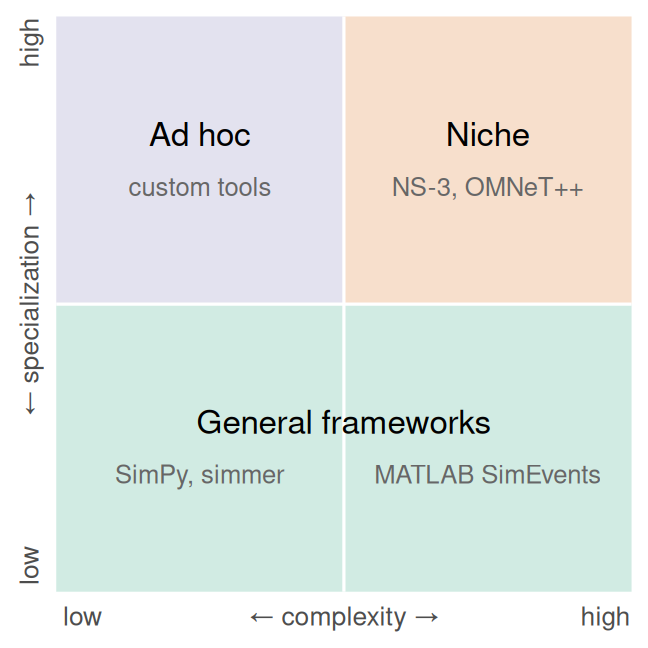
Introduction
Simulation
DES
simmer
Main characteristics:
- General versatile framework for fast prototyping
- Rich and user-friendly R API over a fast C++ simulation core
- Process-oriented trajectory-based modelling
- Automatic monitoring capabilities
- Integration with R: repeatability, analysis, visualization
Introduction
Simulation
DES
simmer
Main characteristics:
- General versatile framework for fast prototyping
- Rich and user-friendly R API over a fast C++ simulation core
- Process-oriented trajectory-based modelling
- Automatic monitoring capabilities
- Integration with R: repeatability, analysis, visualization
Resources:
Online documentation (manual + 10 vignettes): https://r-simmer.org
Ucar I, Smeets B, Azcorra A (2019). “simmer: Discrete-Event Simulation for R.” Journal of Statistical Software, 90(2), 1-30. doi: 10.18637/jss.v090.i02.
Ucar I, Hernández JA, Serrano P, Azcorra A (2018). “Design and Analysis of 5G Scenarios with simmer: An R Package for Fast DES Prototyping.” IEEE Communications Magazine, 56(11), 145-151. doi: 10.1109/MCOM.2018.1700960.
Example: Job Shop
From M. Pidd (1988), Section 5.3.1:
- Jobs are allocated to the first available machine.
- Machines need to be retooled (sometimes) and reset by an operative.
- Operatives may be away attending other tasks.
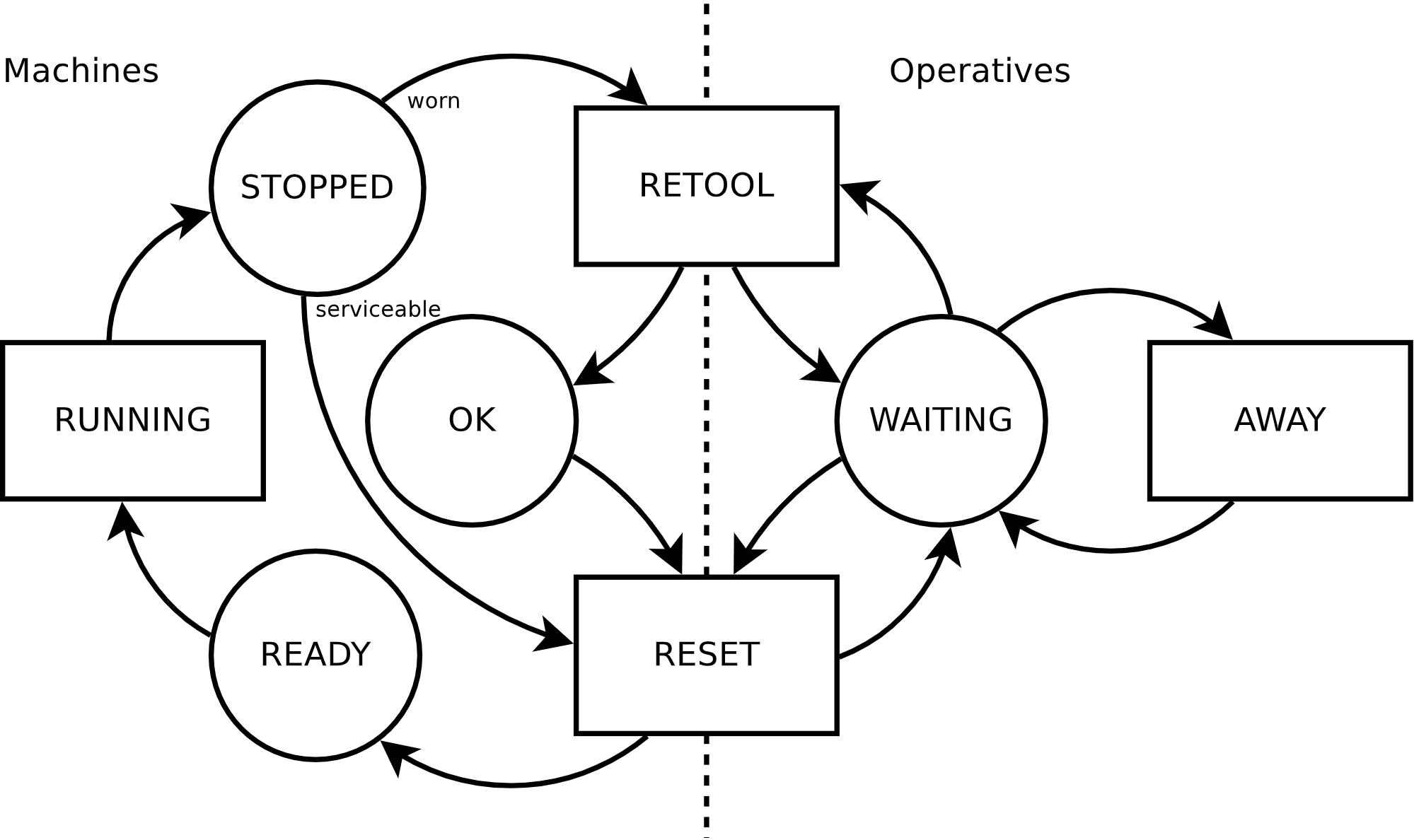
Example: Job Shop
From M. Pidd (1988), Section 5.3.1:
- Jobs are allocated to the first available machine.
- Machines need to be retooled (sometimes) and reset by an operative.
- Operatives may be away attending other tasks.

job <- trajectory() %>% seize("machine") %>% timeout(RUNNING) %>% branch( CHECK_WORN, continue = TRUE, trajectory() %>% seize("operative") %>% timeout(RETOOL) %>% release("operative") ) %>% seize("operative") %>% timeout(RESET) %>% release("operative") %>% release("machine")Example: Job Shop
From M. Pidd (1988), Section 5.3.1:
- Jobs are allocated to the first available machine.
- Machines need to be retooled (sometimes) and reset by an operative.
- Operatives may be away attending other tasks.

job <- trajectory() %>% seize("machine") %>% timeout(RUNNING) %>% branch( CHECK_WORN, continue = TRUE, trajectory() %>% seize("operative") %>% timeout(RETOOL) %>% release("operative") ) %>% seize("operative") %>% timeout(RESET) %>% release("operative") %>% release("machine")task <- trajectory() %>% seize("operative") %>% timeout(AWAY) %>% release("operative")Example: Job Shop
library(simmer); set.seed(1234)RUNNING <- function() rexp(1, 1)CHECK_WORN <- function() runif(1) < 0.2RETOOL <- function() rexp(1, 2)RESET <- function() rexp(1, 3)AWAY <- function() rexp(1, 1)job <- trajectory() %>% seize("machine") %>% timeout(RUNNING) %>% branch( CHECK_WORN, continue = TRUE, trajectory() %>% seize("operative") %>% timeout(RETOOL) %>% release("operative") ) %>% seize("operative") %>% timeout(RESET) %>% release("operative") %>% release("machine")task <- trajectory() %>% seize("operative") %>% timeout(AWAY) %>% release("operative")Example: Job Shop
library(simmer); set.seed(1234)RUNNING <- function() rexp(1, 1)CHECK_WORN <- function() runif(1) < 0.2RETOOL <- function() rexp(1, 2)RESET <- function() rexp(1, 3)AWAY <- function() rexp(1, 1)job <- trajectory() %>% ...task <- trajectory() %>% ...NEW_JOB <- function() rexp(1, 5)NEW_TASK <- function() rexp(1, 1)Example: Job Shop
library(simmer); set.seed(1234)RUNNING <- function() rexp(1, 1)CHECK_WORN <- function() runif(1) < 0.2RETOOL <- function() rexp(1, 2)RESET <- function() rexp(1, 3)AWAY <- function() rexp(1, 1)job <- trajectory() %>% ...task <- trajectory() %>% ...NEW_JOB <- function() rexp(1, 5)NEW_TASK <- function() rexp(1, 1)env <- simmer("Job Shop") %>% add_resource("machine", 10) %>% add_resource("operative", 5) %>% add_generator("job", job, NEW_JOB) %>% add_generator("task", task, NEW_TASK) %>% run(until=1000)env## simmer environment: Job Shop | now: 1000 | next: 1000.09508921831## { Monitor: in memory }## { Resource: machine | monitored: TRUE | server status: 3(10) | queue status: 0(Inf) }## { Resource: operative | monitored: TRUE | server status: 2(5) | queue status: 0(Inf) }## { Source: job | monitored: 1 | n_generated: 5177 }## { Source: task | monitored: 1 | n_generated: 995 }Example: Job Shop
library(simmer); set.seed(1234)RUNNING <- function() rexp(1, 1)CHECK_WORN <- function() runif(1) < 0.2RETOOL <- function() rexp(1, 2)RESET <- function() rexp(1, 3)AWAY <- function() rexp(1, 1)job <- trajectory() %>% ...task <- trajectory() %>% ...NEW_JOB <- function() rexp(1, 5)NEW_TASK <- function() rexp(1, 1)env <- simmer("Job Shop") %>% add_resource("machine", 10) %>% add_resource("operative", 5) %>% add_generator("job", job, NEW_JOB) %>% add_generator("task", task, NEW_TASK) %>% run(until=1000)env## simmer environment: Job Shop | now: 1000 | next: 1000.09508921831## { Monitor: in memory }## { Resource: machine | monitored: TRUE | server status: 3(10) | queue status: 0(Inf) }## { Resource: operative | monitored: TRUE | server status: 2(5) | queue status: 0(Inf) }## { Source: job | monitored: 1 | n_generated: 5177 }## { Source: task | monitored: 1 | n_generated: 995 }aggregate(cbind(server, queue) ~ resource, get_mon_resources(env), mean)## resource server queue## 1 machine 7.987438 1.0355590## 2 operative 3.505732 0.4441298Simulation core design
Architecture
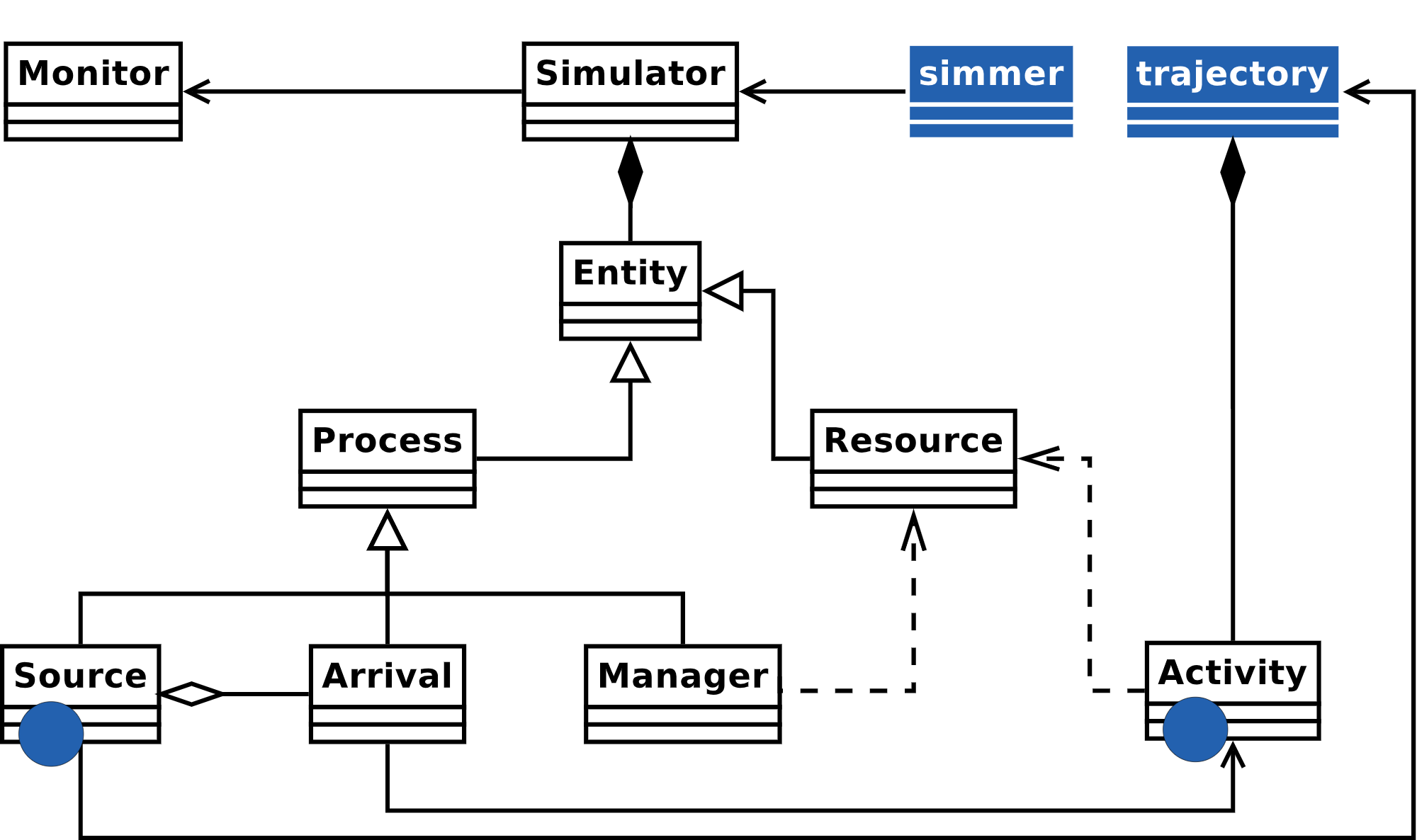
Overview of the C++ core (white) and R API (blue)
Terminology
Simulation core design
Architecture

Overview of the C++ core (white) and R API (blue)
Terminology
Resource: server (configurable capacity) + priority queue (configurable size), supports preemption
Manager: modifies resources at run time (schedule)
Simulation core design
Architecture

Overview of the C++ core (white) and R API (blue)
Terminology
Resource: server (configurable capacity) + priority queue (configurable size), supports preemption
Manager: modifies resources at run time (schedule)
Source: creates new arrivals following some distribution of inter-arrival times
Arrival: interacting processes, with attributes and prioritization values
Simulation core design
Architecture

Overview of the C++ core (white) and R API (blue)
Terminology
Resource: server (configurable capacity) + priority queue (configurable size), supports preemption
Manager: modifies resources at run time (schedule)
Source: creates new arrivals following some distribution of inter-arrival times
Arrival: interacting processes, with attributes and prioritization values
Trajectory: interlinkage of activities, a common path for arrivals of the same type
Activity: unit of action, main building block
The simmer API
Trajectory
Similar to dplyr for data manipulation. In the words of H. Wickham,
by constraining your options, it simplifies how you can think about [something]
- Trajectories are recipes, lists of activities defining the life time of arrivals
- Activities are common functional DES blocks
The simmer API
Trajectory
Similar to dplyr for data manipulation. In the words of H. Wickham,
by constraining your options, it simplifies how you can think about [something]
- Trajectories are recipes, lists of activities defining the life time of arrivals
- Activities are common functional DES blocks
Fixed vs. dynamic parameters:
traj0 <- trajectory() %>% log_("Entering the trajectory") %>% timeout(10) %>% log_("Leaving the trajectory")traj1 <- trajectory() %>% log_(function() "Entering the trajectory") %>% timeout(function() 10) %>% log_(function() "Leaving the trajectory")The simmer API
Trajectory
Activities
- Spend time in the system
timeout,timeout_from_attribute,timeout_from_global
- Modify arrival properties
set_attribute,set_globalset_prioritization
- Interaction with resources
seize,releaseset_capacity,set_queue_sizeselect,seize_selected...
- Interaction with sources
activate,deactivateset_trajectory,set_source
- Loops
rollback
- Branching
branchclone,synchronize
- Batching
batch,separate
- Inter-arrival communication
send,trap,untrap,wait
- Reneging
leaverenege_in,renege_if,renege_aborthandle_unfinished
- Debugging
log_stop_if
The simmer API
Trajectory
Activities
- Spend time in the system
timeout,timeout_from_attribute,timeout_from_global
- Modify arrival properties
set_attribute,set_globalset_prioritization
- Interaction with resources
seize,releaseset_capacity,set_queue_sizeselect,seize_selected...
- Interaction with sources
activate,deactivateset_trajectory,set_source
- Loops
rollback
- Branching
branchclone,synchronize
- Batching
batch,separate
- Inter-arrival communication
send,trap,untrap,wait
- Reneging
leaverenege_in,renege_if,renege_aborthandle_unfinished
- Debugging
log_stop_if
(Plus many getters to retrieve parameters at run time)
The simmer API
Trajectory
Activities
Simulation environment
- Create a simulator and attach a monitor
simmermonitor_mem(default),monitor_csv... (extensible, seesimmer.monon GitHub)
The simmer API
Trajectory
Activities
Simulation environment
- Create a simulator and attach a monitor
simmermonitor_mem(default),monitor_csv... (extensible, seesimmer.monon GitHub)
- Add sources of arrivals
add_generator: based on a distribution functionadd_dataframe: based on a data frame (additional columns as attributes)
The simmer API
Trajectory
Activities
Simulation environment
- Create a simulator and attach a monitor
simmermonitor_mem(default),monitor_csv... (extensible, seesimmer.monon GitHub)
- Add sources of arrivals
add_generator: based on a distribution functionadd_dataframe: based on a data frame (additional columns as attributes)
- Add resources
add_resource: priority resource, with capacity and queue size; optional preemption
The simmer API
Trajectory
Activities
Simulation environment
- Create a simulator and attach a monitor
simmermonitor_mem(default),monitor_csv... (extensible, seesimmer.monon GitHub)
- Add sources of arrivals
add_generator: based on a distribution functionadd_dataframe: based on a data frame (additional columns as attributes)
- Add resources
add_resource: priority resource, with capacity and queue size; optional preemption
- Add global variables
add_global
The simmer API
Trajectory
Activities
Simulation environment
- Create a simulator and attach a monitor
simmermonitor_mem(default),monitor_csv... (extensible, seesimmer.monon GitHub)
- Add sources of arrivals
add_generator: based on a distribution functionadd_dataframe: based on a data frame (additional columns as attributes)
- Add resources
add_resource: priority resource, with capacity and queue size; optional preemption
- Add global variables
add_global
- Run the simulation
run,stepn
The simmer API
Trajectory
Activities
Simulation environment
Monitoring
simmer automatically records every change in the state of the system. All these statistics can be retrieved after the simulation:
names( get_mon_arrivals(simmer(), per_resource=FALSE) )## [1] "name" "start_time" "end_time" "activity_time"## [5] "finished"names( get_mon_arrivals(simmer(), per_resource=TRUE) )## [1] "name" "start_time" "end_time" "activity_time"## [5] "resource"names( get_mon_attributes(simmer()) )## [1] "time" "name" "key" "value"names( get_mon_resources(simmer()) )## [1] "resource" "time" "server" "queue" "capacity" ## [6] "queue_size" "system" "limit"Modelling
Queueing systems
Natural way to simulate CTMC and birth-death processes:
set.seed(1234)lambda <- 2mu <- 4rho <- lambda/mumm1.traj <- trajectory() %>% seize("mm1.resource", 1) %>% timeout(function() rexp(1, mu)) %>% release("mm1.resource", 1)mm1.env <- simmer() %>% add_resource("mm1.resource", 1, Inf) %>% add_generator("arrival", mm1.traj, function() rexp(1, lambda)) %>% run(2000)Modelling
Queueing systems
Natural way to simulate CTMC and birth-death processes:
set.seed(1234)lambda <- 2mu <- 4rho <- lambda/mumm1.traj <- trajectory() %>% seize("mm1.resource", 1) %>% timeout(function() rexp(1, mu)) %>% release("mm1.resource", 1)mm1.env <- simmer() %>% add_resource("mm1.resource", 1, Inf) %>% add_generator("arrival", mm1.traj, function() rexp(1, lambda)) %>% run(2000)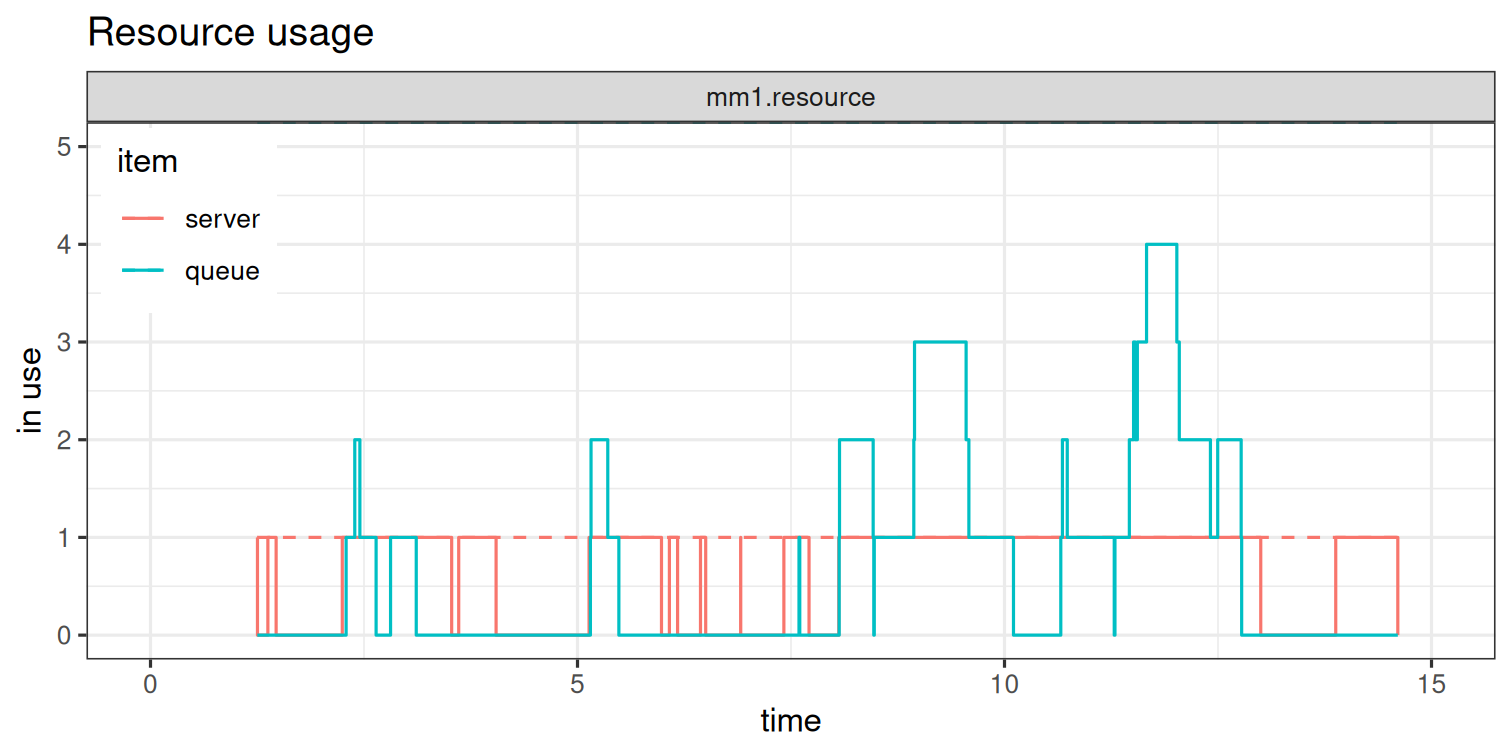
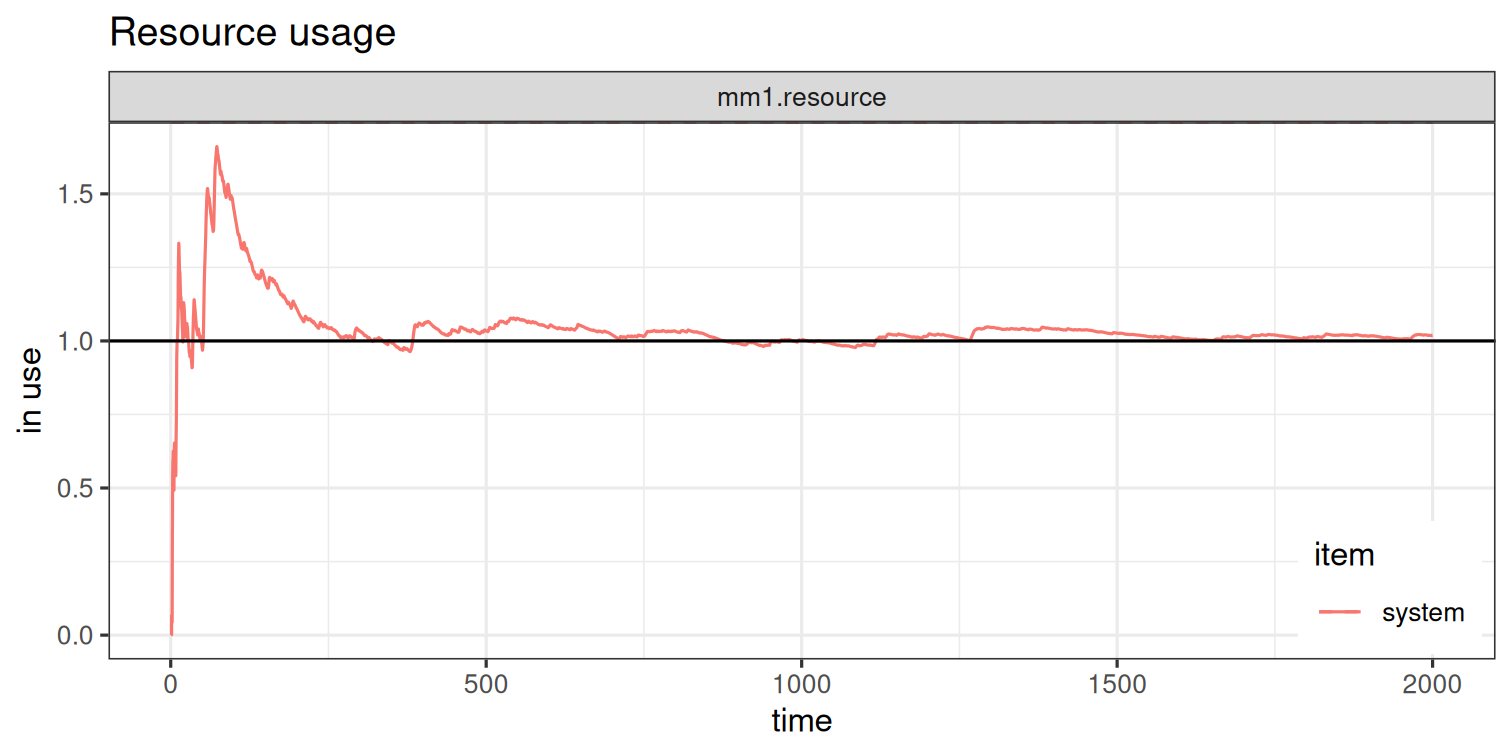
Modelling
Replication
Easy replication with standard R functions:
mm1.envs <- lapply(1:20, function(i) { simmer() %>% add_resource("mm1.resource", 1, Inf) %>% add_generator("arrival", mm1.traj, function() rexp(100, lambda)) %>% run(1000/lambda)})Modelling
Replication
Easy replication with standard R functions:
mm1.envs <- lapply(1:20, function(i) { simmer() %>% add_resource("mm1.resource", 1, Inf) %>% add_generator("arrival", mm1.traj, function() rexp(100, lambda)) %>% run(1000/lambda)})Parallelization
Even easier parallelization of replicas:
mm1.envs <- parallel::mclapply(1:20, function(i) { simmer() %>% add_resource("mm1.resource", 1, Inf) %>% add_generator("arrival", mm1.traj, function() rexp(100, lambda)) %>% run(1000/lambda) %>% wrap()}, mc.cores=4)Modelling
Replication
Easy replication with standard R functions:
mm1.envs <- lapply(1:20, function(i) { simmer() %>% add_resource("mm1.resource", 1, Inf) %>% add_generator("arrival", mm1.traj, function() rexp(100, lambda)) %>% run(1000/lambda)})Parallelization
Even easier parallelization of replicas:
mm1.envs <- parallel::mclapply(1:20, function(i) { simmer() %>% add_resource("mm1.resource", 1, Inf) %>% add_generator("arrival", mm1.traj, function() rexp(100, lambda)) %>% run(1000/lambda) %>% wrap()}, mc.cores=4)head(get_mon_arrivals(mm1.envs), 3)## name start_time end_time activity_time finished replication## 1 arrival0 0.04471412 0.2337613 0.189047164 TRUE 1## 2 arrival1 0.17734846 0.2384445 0.004683229 TRUE 1## 3 arrival2 0.52254010 0.9208069 0.398266801 TRUE 1Modelling
Best practices
There are usually multiple valid ways of mapping the identified resources and processes into the simmer API
Modelling
Best practices
There are usually multiple valid ways of mapping the identified resources and processes into the simmer API
Design pattern 1
beep <- trajectory() %>% log_("beeeep!")env <- simmer() %>% add_generator("beep", beep, function() 1) %>% run(2.5)## 1: beep0: beeeep!## 2: beep1: beeeep!Modelling
Best practices
There are usually multiple valid ways of mapping the identified resources and processes into the simmer API
Design pattern 1
beep <- trajectory() %>% log_("beeeep!")env <- simmer() %>% add_generator("beep", beep, function() 1) %>% run(2.5)## 1: beep0: beeeep!## 2: beep1: beeeep!Design pattern 2
alarm <- trajectory() %>% timeout(1) %>% log_("beeeep!") %>% rollback(2)env <- simmer() %>% add_generator("alarm", alarm, at(0)) %>% run(2.5)## 1: alarm0: beeeep!## 2: alarm0: beeeep!Performance
Comparison with similar frameworks (out-of-date!):
- SimPy 3.0.9, Python 2.7
- SimJulia 0.3.14, Julia 0.5.1
Heavy M/M/1, ρ≈0.9:
test_mm1_simmer <- function(n, m, mon=FALSE) { mm1 <- trajectory() %>% seize("server", 1) %>% timeout(function() rexp(1, 1.1)) %>% release("server", 1) env <- simmer() %>% add_resource("server", 1, mon=mon) %>% add_generator("customer", mm1, function() rexp(m, 1), mon=mon) %>% run(until=n)}Performance
Comparison with similar frameworks (out-of-date!):
- SimPy 3.0.9, Python 2.7
- SimJulia 0.3.14, Julia 0.5.1
Heavy M/M/1, ρ≈0.9:
test_mm1_simmer <- function(n, m, mon=FALSE) { mm1 <- trajectory() %>% seize("server", 1) %>% timeout(function() rexp(1, 1.1)) %>% release("server", 1) env <- simmer() %>% add_resource("server", 1, mon=mon) %>% add_generator("customer", mm1, function() rexp(m, 1), mon=mon) %>% run(until=n)}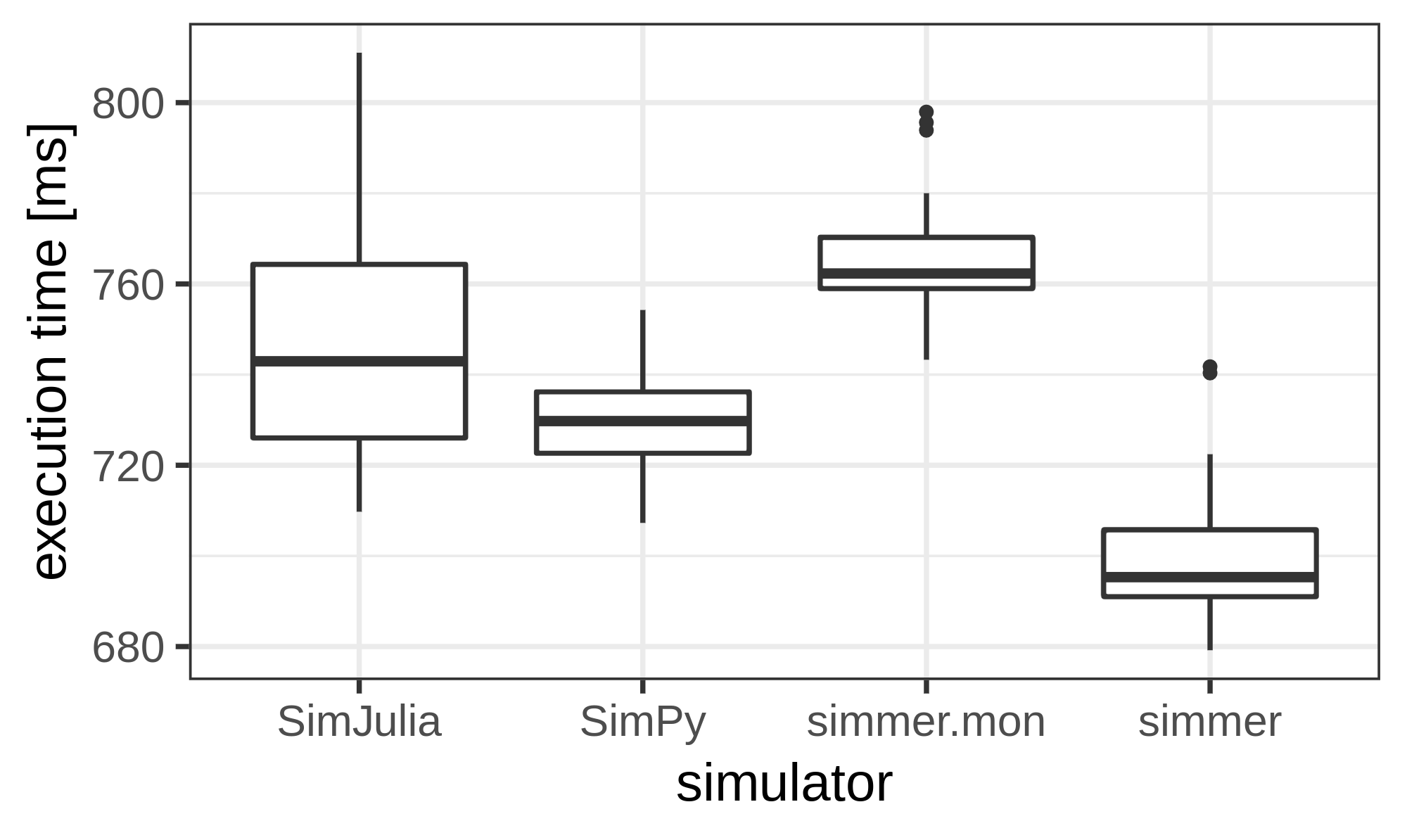
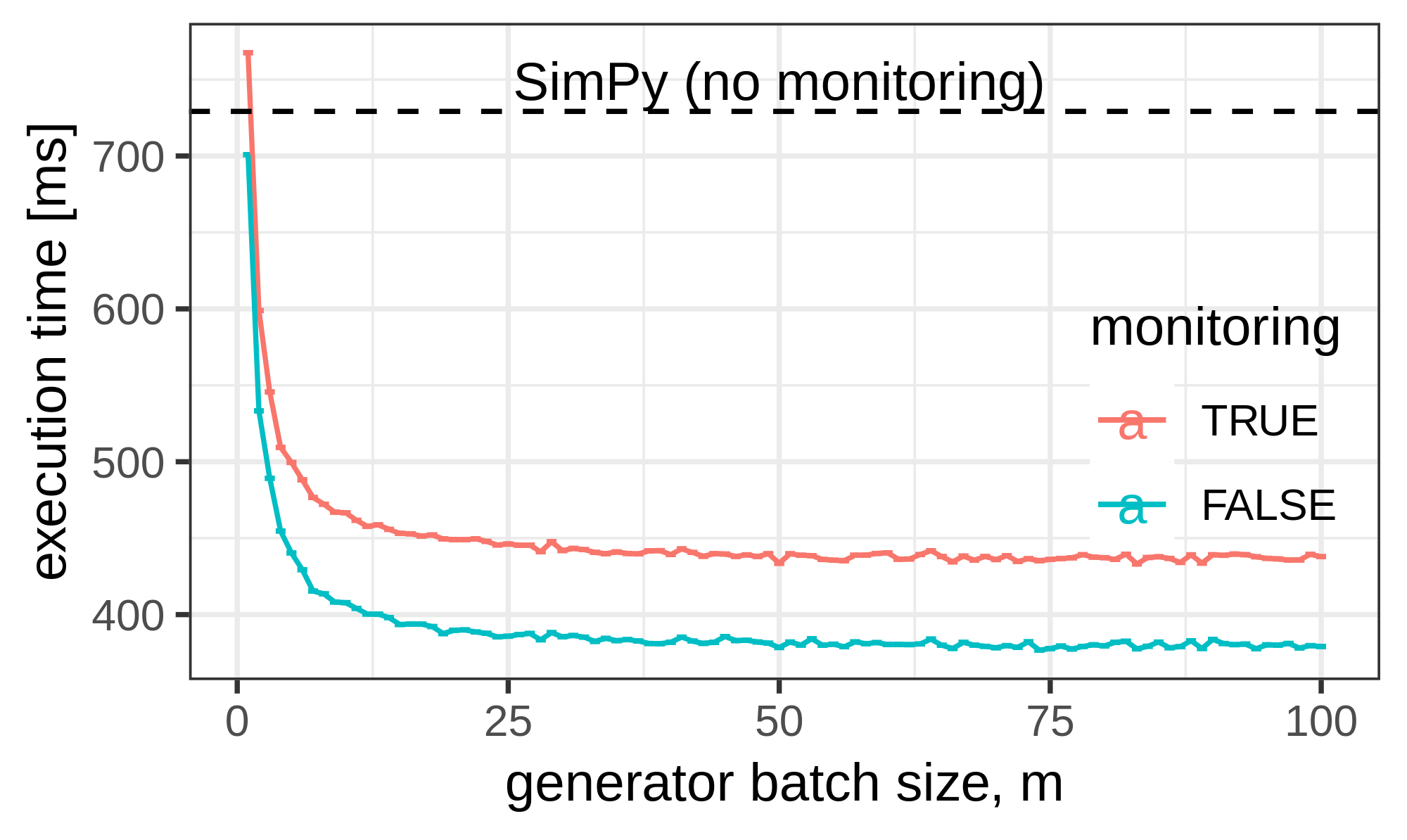
Performance
The cost of calling R from C++ revisited
Very simple deterministic test to study the impact:
test_simmer <- function(n, delay) { test <- trajectory() %>% timeout(delay) simmer() %>% add_generator("test", test, at(1:n)) %>% run() %>% get_mon_arrivals()}test_simmer(5, 1)[,1:5]## name start_time end_time activity_time finished## 1 test0 1 2 1 TRUE## 2 test1 2 3 1 TRUE## 3 test2 3 4 1 TRUE## 4 test3 4 5 1 TRUE## 5 test4 5 6 1 TRUEPerformance
The cost of calling R from C++ revisited
Very simple deterministic test to study the impact:
test_simmer <- function(n, delay) { test <- trajectory() %>% timeout(delay) simmer() %>% add_generator("test", test, at(1:n)) %>% run() %>% get_mon_arrivals()}test_simmer(5, 1)[,1:5]## name start_time end_time activity_time finished## 1 test0 1 2 1 TRUE## 2 test1 2 3 1 TRUE## 3 test2 3 4 1 TRUE## 4 test3 4 5 1 TRUE## 5 test4 5 6 1 TRUEOriginal benchmark in the JSS paper:
| Expr | Min | Mean | Median | Max |
|---|---|---|---|---|
| test_simmer(n, 1) | 429.8663 | 492.365 | 480.5408 | 599.3547 |
| test_simmer(n, function() 1) | 3067.9957 | 3176.963 | 3165.6859 | 3434.7979 |
| test_R_for(n) | 2053.0840 | 2176.164 | 2102.5848 | 2438.6836 |
Performance
The cost of calling R from C++ revisited
Very simple deterministic test to study the impact:
test_simmer <- function(n, delay) { test <- trajectory() %>% timeout(delay) simmer() %>% add_generator("test", test, at(1:n)) %>% run() %>% get_mon_arrivals()}test_simmer(5, 1)[,1:5]## name start_time end_time activity_time finished## 1 test0 1 2 1 TRUE## 2 test1 2 3 1 TRUE## 3 test2 3 4 1 TRUE## 4 test3 4 5 1 TRUE## 5 test4 5 6 1 TRUEOriginal benchmark in the JSS paper:
| Expr | Min | Mean | Median | Max |
|---|---|---|---|---|
| test_simmer(n, 1) | 429.8663 | 492.365 | 480.5408 | 599.3547 |
| test_simmer(n, function() 1) | 3067.9957 | 3176.963 | 3165.6859 | 3434.7979 |
| test_R_for(n) | 2053.0840 | 2176.164 | 2102.5848 | 2438.6836 |
Update with -DRCPP_USE_UNWIND_PROTECT:
| Expr | Min | Mean | Median | Max |
|---|---|---|---|---|
| test_simmer(n, 1) | 467.8971 | 481.213 | 476.1667 | 521.4916 |
| test_simmer(n, function() 1) | 498.2631 | 583.777 | 561.6798 | 816.1343 |
| test_R_for(n) | 1158.9348 | 1201.460 | 1196.7223 | 1244.4041 |
Summary
Generic yet powerful process-oriented Discrete-Event Simulation framework for R [1, 2]
Combines a robust and fast C++ simulation core with a rich and flexible R API
[1] Ucar I, Smeets B, Azcorra A (2019). “simmer: Discrete-Event Simulation for R.” Journal of Statistical Software, 90(2), 1-30. doi: 10.18637/jss.v090.i02.
[2] Ucar I, Hernández JA, Serrano P, Azcorra A (2018). “Design and Analysis of 5G Scenarios with simmer: An R Package for Fast DES Prototyping.” IEEE Communications Magazine, 56(11), 145-151. doi: 10.1109/MCOM.2018.1700960.
Summary
Generic yet powerful process-oriented Discrete-Event Simulation framework for R [1, 2]
Combines a robust and fast C++ simulation core with a rich and flexible R API
[1] Ucar I, Smeets B, Azcorra A (2019). “simmer: Discrete-Event Simulation for R.” Journal of Statistical Software, 90(2), 1-30. doi: 10.18637/jss.v090.i02.
[2] Ucar I, Hernández JA, Serrano P, Azcorra A (2018). “Design and Analysis of 5G Scenarios with simmer: An R Package for Fast DES Prototyping.” IEEE Communications Magazine, 56(11), 145-151. doi: 10.1109/MCOM.2018.1700960.
Broad set of activities, the basic building block; extensible via custom routines
Activities are chained into a trajectory, a common path for processes of the same type
Summary
Generic yet powerful process-oriented Discrete-Event Simulation framework for R [1, 2]
Combines a robust and fast C++ simulation core with a rich and flexible R API
[1] Ucar I, Smeets B, Azcorra A (2019). “simmer: Discrete-Event Simulation for R.” Journal of Statistical Software, 90(2), 1-30. doi: 10.18637/jss.v090.i02.
[2] Ucar I, Hernández JA, Serrano P, Azcorra A (2018). “Design and Analysis of 5G Scenarios with simmer: An R Package for Fast DES Prototyping.” IEEE Communications Magazine, 56(11), 145-151. doi: 10.1109/MCOM.2018.1700960.
Broad set of activities, the basic building block; extensible via custom routines
Activities are chained into a trajectory, a common path for processes of the same type
- Automatic monitoring: focus on modelling
Summary
Generic yet powerful process-oriented Discrete-Event Simulation framework for R [1, 2]
Combines a robust and fast C++ simulation core with a rich and flexible R API
[1] Ucar I, Smeets B, Azcorra A (2019). “simmer: Discrete-Event Simulation for R.” Journal of Statistical Software, 90(2), 1-30. doi: 10.18637/jss.v090.i02.
[2] Ucar I, Hernández JA, Serrano P, Azcorra A (2018). “Design and Analysis of 5G Scenarios with simmer: An R Package for Fast DES Prototyping.” IEEE Communications Magazine, 56(11), 145-151. doi: 10.1109/MCOM.2018.1700960.
Broad set of activities, the basic building block; extensible via custom routines
Activities are chained into a trajectory, a common path for processes of the same type
- Automatic monitoring: focus on modelling
- Integration: easy replication, parallelization, analysis...

